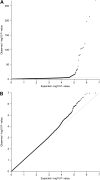Genome-wide meta-analysis of common variant differences between men and women
- PMID: 22843499
- PMCID: PMC3471397
- DOI: 10.1093/hmg/dds304
Genome-wide meta-analysis of common variant differences between men and women
Abstract
The male-to-female sex ratio at birth is constant across world populations with an average of 1.06 (106 male to 100 female live births) for populations of European descent. The sex ratio is considered to be affected by numerous biological and environmental factors and to have a heritable component. The aim of this study was to investigate the presence of common allele modest effects at autosomal and chromosome X variants that could explain the observed sex ratio at birth. We conducted a large-scale genome-wide association scan (GWAS) meta-analysis across 51 studies, comprising overall 114 863 individuals (61 094 women and 53 769 men) of European ancestry and 2 623 828 common (minor allele frequency >0.05) single-nucleotide polymorphisms (SNPs). Allele frequencies were compared between men and women for directly-typed and imputed variants within each study. Forward-time simulations for unlinked, neutral, autosomal, common loci were performed under the demographic model for European populations with a fixed sex ratio and a random mating scheme to assess the probability of detecting significant allele frequency differences. We do not detect any genome-wide significant (P < 5 × 10(-8)) common SNP differences between men and women in this well-powered meta-analysis. The simulated data provided results entirely consistent with these findings. This large-scale investigation across ~115 000 individuals shows no detectable contribution from common genetic variants to the observed skew in the sex ratio. The absence of sex-specific differences is useful in guiding genetic association study design, for example when using mixed controls for sex-biased traits.
Figures
References
-
- Kaba A.J. Sex ratio at birth and racial differences: why do black women give birth to more females than non-black women? Afr. J. Reprod. Health. 2008;12:139–150. - PubMed
-
- James W.H. The human sex ratio. Part 1: a review of the literature. Hum. Biol. 1987;59:721–752. - PubMed
-
- Chahnazarian A. Determinants of the sex ratio at birth: review of recent literature. Soc. Biol. 1988;35:214–235. - PubMed
Publication types
MeSH terms
Grants and funding
- R01 AA007535/AA/NIAAA NIH HHS/United States
- ImNIH/Intramural NIH HHS/United States
- DK062370/DK/NIDDK NIH HHS/United States
- 089062/Z/09/Z/WT_/Wellcome Trust/United Kingdom
- 098051/WT_/Wellcome Trust/United Kingdom
- N01-AG-5-0002/AG/NIA NIH HHS/United States
- HHSN268201100012C/HL/NHLBI NIH HHS/United States
- UL1RR025005/RR/NCRR NIH HHS/United States
- HL67466/HL/NHLBI NIH HHS/United States
- CZB/4/710/CSO_/Chief Scientist Office/United Kingdom
- G1001799/MRC_/Medical Research Council/United Kingdom
- HHSN268201100009I/HL/NHLBI NIH HHS/United States
- R01 HL065234/HL/NHLBI NIH HHS/United States
- R56 DK062370/DK/NIDDK NIH HHS/United States
- R01 AA014041/AA/NIAAA NIH HHS/United States
- K05 AA017688/AA/NIAAA NIH HHS/United States
- HL65234/HL/NHLBI NIH HHS/United States
- R01 MH081802/MH/NIMH NIH HHS/United States
- R01 MH066206/MH/NIMH NIH HHS/United States
- MOP-82893/CAPMC/ CIHR/Canada
- R01HL59367/HL/NHLBI NIH HHS/United States
- HHSN268201100010C/HL/NHLBI NIH HHS/United States
- UL1 RR025005/RR/NCRR NIH HHS/United States
- AA13320/AA/NIAAA NIH HHS/United States
- N.1-AG-1-2111/AG/NIA NIH HHS/United States
- HHSN268201100008C/HL/NHLBI NIH HHS/United States
- HHSN268201100005G/HL/NHLBI NIH HHS/United States
- HHSN268201100008I/HL/NHLBI NIH HHS/United States
- R01 MH062633/MH/NIMH NIH HHS/United States
- R01 HL059367/HL/NHLBI NIH HHS/United States
- HHSN268201100007C/HL/NHLBI NIH HHS/United States
- R01 MD009164/MD/NIMHD NIH HHS/United States
- MC_U127561128/MRC_/Medical Research Council/United Kingdom
- R01 HL067466/HL/NHLBI NIH HHS/United States
- AA13321/AA/NIAAA NIH HHS/United States
- AA10248/AA/NIAAA NIH HHS/United States
- HHSN268201100011I/HL/NHLBI NIH HHS/United States
- P20 RR018787/RR/NCRR NIH HHS/United States
- HHSN268201100011C/HL/NHLBI NIH HHS/United States
- R01 HL086694/HL/NHLBI NIH HHS/United States
- R01 AA013326/AA/NIAAA NIH HHS/United States
- G1000143/MRC_/Medical Research Council/United Kingdom
- MH66206/MH/NIMH NIH HHS/United States
- 092447/Z/10/Z/WT_/Wellcome Trust/United Kingdom
- U01 HG004402/HG/NHGRI NIH HHS/United States
- N01-AG-1-2100/AG/NIA NIH HHS/United States
- 076113/WT_/Wellcome Trust/United Kingdom
- R01 DK062370/DK/NIDDK NIH HHS/United States
- U01HG004402/HG/NHGRI NIH HHS/United States
- R01 AA013321/AA/NIAAA NIH HHS/United States
- MC_U106179471/MRC_/Medical Research Council/United Kingdom
- R01 MH059160/MH/NIMH NIH HHS/United States
- HHSN268201100006C/HL/NHLBI NIH HHS/United States
- RR018787/RR/NCRR NIH HHS/United States
- 095831/WT_/Wellcome Trust/United Kingdom
- R01HL087641/HL/NHLBI NIH HHS/United States
- HHSN268201100005I/HL/NHLBI NIH HHS/United States
- G0401527/MRC_/Medical Research Council/United Kingdom
- N.1-AG-1-1/AG/NIA NIH HHS/United States
- 89061/Z/09/Z/WT_/Wellcome Trust/United Kingdom
- R01 LM010098/LM/NLM NIH HHS/United States
- MC_PC_U127561128/MRC_/Medical Research Council/United Kingdom
- U24 MH068457/MH/NIMH NIH HHS/United States
- U01 DK062370/DK/NIDDK NIH HHS/United States
- G0600717/MRC_/Medical Research Council/United Kingdom
- HHSN268201100009C/HL/NHLBI NIH HHS/United States
- HHSN268201100005C/HL/NHLBI NIH HHS/United States
- P30 DK020572/DK/NIDDK NIH HHS/United States
- HHSN268201100007I/HL/NHLBI NIH HHS/United States
- U24 MH068457-06/MH/NIMH NIH HHS/United States
- AA14041/AA/NIAAA NIH HHS/United States
- R01 HL087641/HL/NHLBI NIH HHS/United States
- AA13326/AA/NIAAA NIH HHS/United States
- CRUK_/Cancer Research UK/United Kingdom
- R01 AA013320/AA/NIAAA NIH HHS/United States
- R01HL086694/HL/NHLBI NIH HHS/United States
- LM010098/LM/NLM NIH HHS/United States
- MH081802/MH/NIMH NIH HHS/United States


